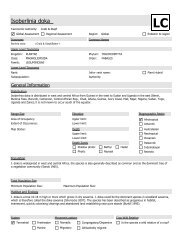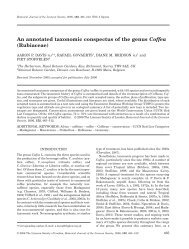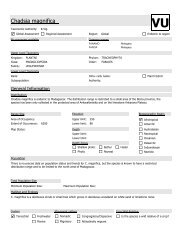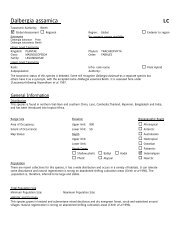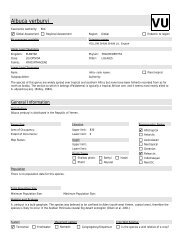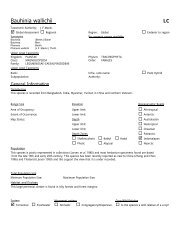Flemingia involucrata - Sampled Red List Index for Plants
Flemingia involucrata - Sampled Red List Index for Plants
Flemingia involucrata - Sampled Red List Index for Plants
You also want an ePaper? Increase the reach of your titles
YUMPU automatically turns print PDFs into web optimized ePapers that Google loves.
<strong>Flemingia</strong> <strong>involucrata</strong><br />
Taxonomic Authority: Benth.<br />
<br />
Global Assessment<br />
<br />
Regional Assessment<br />
Region:<br />
Global<br />
<br />
LC<br />
Endemic to region<br />
Synonyms<br />
Moghania <strong>involucrata</strong> (Benth.) Kuntze<br />
Psoralea testariae F.Muell.<br />
Common Names<br />
Upper Level Taxonomy<br />
Kingdom: PLANTAE Phylum: TRACHEOPHYTA<br />
Class: MAGNOLIOPSIDA<br />
Order: FABALES<br />
Family: LEGUMINOSAE<br />
Lower Level Taxonomy<br />
Rank:<br />
Subpopulation:<br />
Infra- rank name:<br />
Authority:<br />
Plant Hybrid<br />
General In<strong>for</strong>mation<br />
Distribution<br />
<strong>Flemingia</strong> <strong>involucrata</strong> is widespread in southern Asia extending south into northern Australia. In China, Bangladesh, Cambodia,<br />
India, Indonesia, Laos, Malaysia, Myanmar, Philippines, Thailand, Vietnam and Australia.<br />
Range Size<br />
Area of Occupancy: Upper limit: 1000<br />
Extent of Occurrence:<br />
Lower limit: 0<br />
Map Status:<br />
Population<br />
Elevation<br />
Depth<br />
Upper limit:<br />
Lower limit:<br />
Depth Zones<br />
Shallow photic<br />
Photic<br />
Bathyl<br />
Abyssal<br />
Total population size is not known but it was recentry collected in 2008 in Australia.<br />
Hadal<br />
Biogeographic Realm<br />
Afrotropical<br />
Antarctic<br />
Australasian<br />
Neotropical<br />
Oceanian<br />
Palearctic<br />
Indomalayan<br />
Nearctic<br />
Total Population Size<br />
Minimum Population Size:<br />
Maximum Population Size:<br />
Habitat and Ecology<br />
Perennial herb or shrub growing often on lateritic loam in Eucalyptus/palm woodland and also in disturbed grasslands.<br />
System<br />
Terrestrial<br />
Freshwater<br />
Marine<br />
Movement pattern<br />
Nomadic Congregatory/Dispersive<br />
Migratory Altitudinally migrant<br />
Crop Wild Relative<br />
Is the species a wild relative of a crop?
Growth From<br />
Forb or Herb<br />
Shrub - large<br />
Definition<br />
Biennial or perennial herbacaeous plant, also termed a Hemicryptophyte<br />
Perennial shrub (>1m), also termed a Phanerophyte (>1m)<br />
Threats<br />
There are no major threats known to this species.<br />
Past Present Future<br />
13 None <br />
Conservation Measures<br />
This species is known to occur in protected areas. This species is not listed as Threatened in the Environment Protection and<br />
Biodiversity Conservation Act 1999 (EPBC Act). It is recommended that its seeds are banked <strong>for</strong> ex situ conservation.<br />
In Place Needed<br />
4 Habitat and site-based actions <br />
4.4 Protected areas <br />
5 Species-based actions <br />
5.7 Ex situ conservation actions <br />
5.7.2 Genome resource bank <br />
Countries of Occurrence<br />
PRESENCE<br />
ORIGIN<br />
Year Breeding Nonbreeding<br />
Passage Possibly Extinct Presence Native Introduced Re- Vagrant Origin<br />
Round Season<br />
only migrant<br />
season only<br />
extinct uncertain<br />
Introduced uncertain<br />
Australia <br />
Northern Territory <br />
Queensland <br />
Western Australia <br />
Bangladesh <br />
Cambodia <br />
China <br />
Yunnan <br />
India <br />
Arunachal Pradesh <br />
Assam <br />
Bihar <br />
Karnataka <br />
Madhya Pradesh <br />
Maharashtra <br />
Orissa <br />
Uttar Pradesh <br />
West Bengal <br />
Indonesia <br />
Bali <br />
Java <br />
Lesser Sunda Is. <br />
Papua <br />
Lao People's Democratic <br />
Republic<br />
Malaysia
Myanmar <br />
Papua New Guinea <br />
Philippines <br />
Thailand <br />
Viet Nam <br />
General Habitats Score Description Major<br />
Importance<br />
2 Savanna 1 Suitable<br />
Unset<br />
2.1 Savanna - Dry 1 Suitable<br />
Unset<br />
3 Shrubland 1 Suitable<br />
Unset<br />
3.8 Shrubland - Mediterranean-type Shrubby Vegetation 1 Suitable<br />
Unset<br />
4 Grassland 1 Suitable<br />
Unset<br />
4.5 Grassland - Subtropical/Tropical Dry 1 Suitable<br />
Unset<br />
Species Utilisation<br />
<br />
Species is not utilised at all<br />
Trend in the level of wild offtake/harvest in relation to total wild population numbers over the last five years:<br />
Trend in the amount of offtake/harvest produced through domestication/cultivation over the last five years:<br />
CITES status: Not listed<br />
IUCN <strong>Red</strong> <strong>List</strong>ing<br />
<strong>Red</strong> <strong>List</strong> Assessment:<br />
(using 2001 IUCN system)<br />
Least Concern (LC)<br />
<strong>Red</strong> <strong>List</strong> Criteria:<br />
Date Last Seen (only <strong>for</strong> EX, EW or Possibly EX species):<br />
Is the species Possibly Extinct? Possibly Extinct Candidate? <br />
Rationale <strong>for</strong> the <strong>Red</strong> <strong>List</strong> Assessment<br />
F. <strong>involucrata</strong> is listed here as Least Corncern in view of its wide distribution across southern Asia, from India extending south<br />
into Australia. Moreover it is known to occur across several protected areas in its range and there are no major threats known to<br />
the species. It is recommended that the seeds of this species are banked as an ex situ conservation measure.<br />
Reason(s) <strong>for</strong> Change in <strong>Red</strong> <strong>List</strong> Category from the Previous Assessment:<br />
Genuine Change<br />
Nongenuine Change<br />
Genuine (recent)<br />
New in<strong>for</strong>mation<br />
Genuine (since first assessment) Knowledge of Criteria<br />
Incorrect data used<br />
previously<br />
Current Population Trend: Stable Date of Assessment: 03/08/2010<br />
Name(s) of the Assessor(s): Malcolm, P.<br />
Evaluator(s):<br />
Notes:<br />
% population decline in the past:<br />
No Change<br />
Taxonomy <br />
Criteria Revisio<br />
Other<br />
<br />
Same category<br />
and criteria<br />
Same category but<br />
change in criteria
Time period over which the past decline has been measured <strong>for</strong><br />
applying Criterion A or C1 (in years or generations):<br />
% population decline in the future:<br />
Time period over which the future decline has been measured <strong>for</strong><br />
applying Criterion A or C1 (in years or generations):<br />
Number of Locations:<br />
Number of Mature Individuals:<br />
Severely Fragmented:<br />
Bibliography<br />
Commonwealth of Australia, 1999, Environment Protection and Biodiversity Conservation Act 1999 (EPBC Act)10 June 2010, , ,<br />
Hacker, J.B., 1990, A guide to herbaceous and shrub legumes of Queensland, , University of Queensland Press, St Lucia<br />
Wheeler, J.R., 1992, Flora of the Kimberley region, J.R. Wheeler, , Western Australian Herbarium, Department of Conservation<br />
and Land Management, Perth



